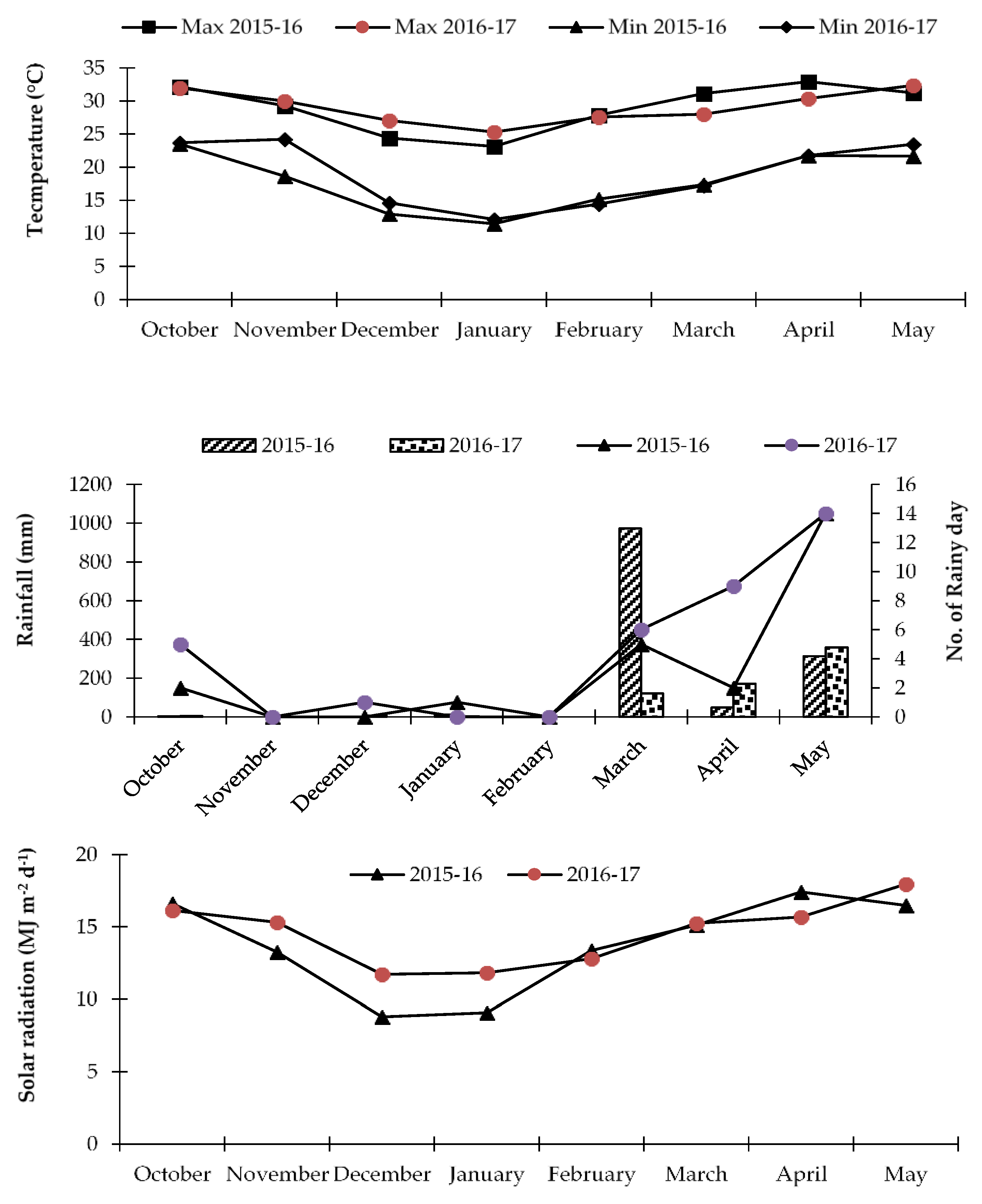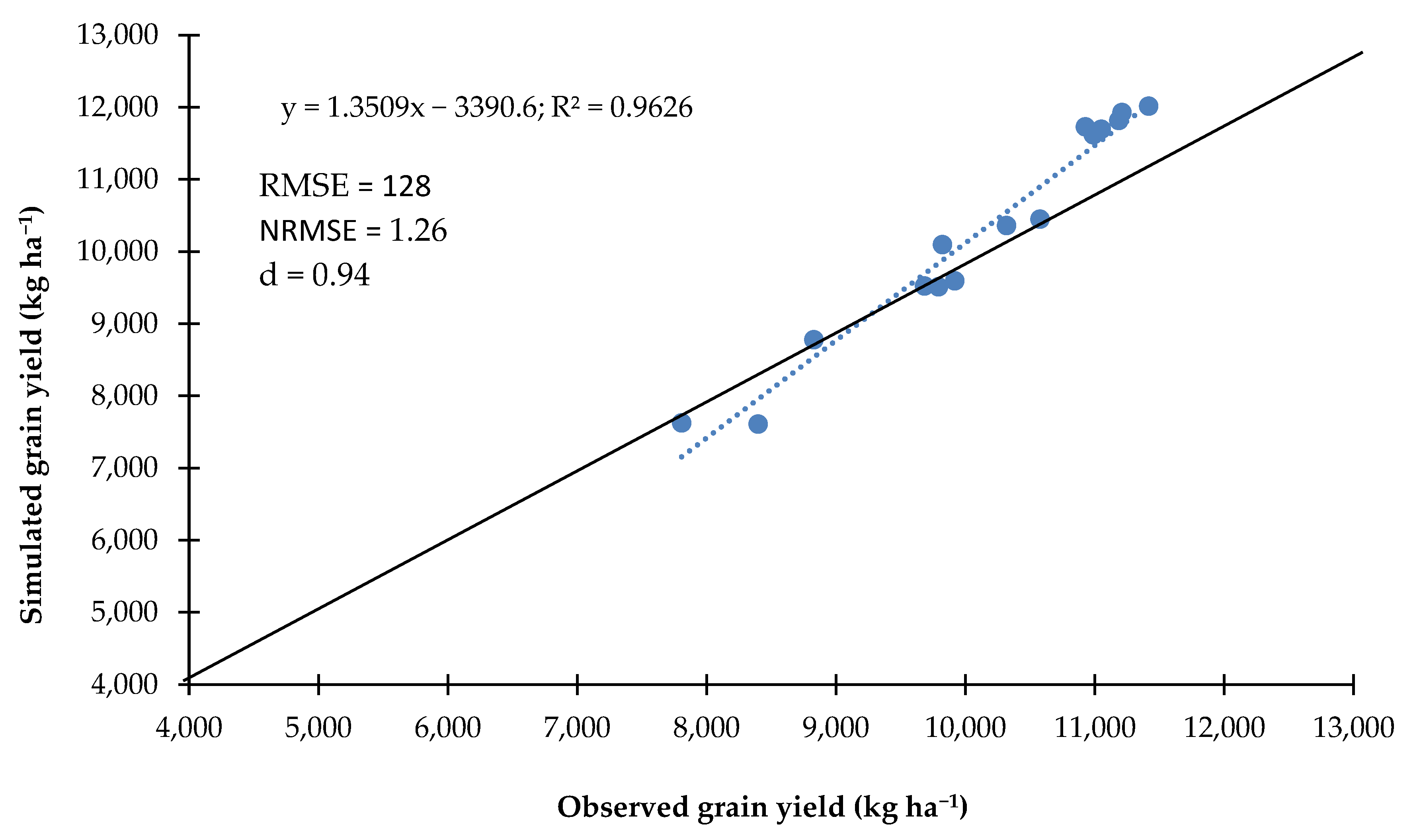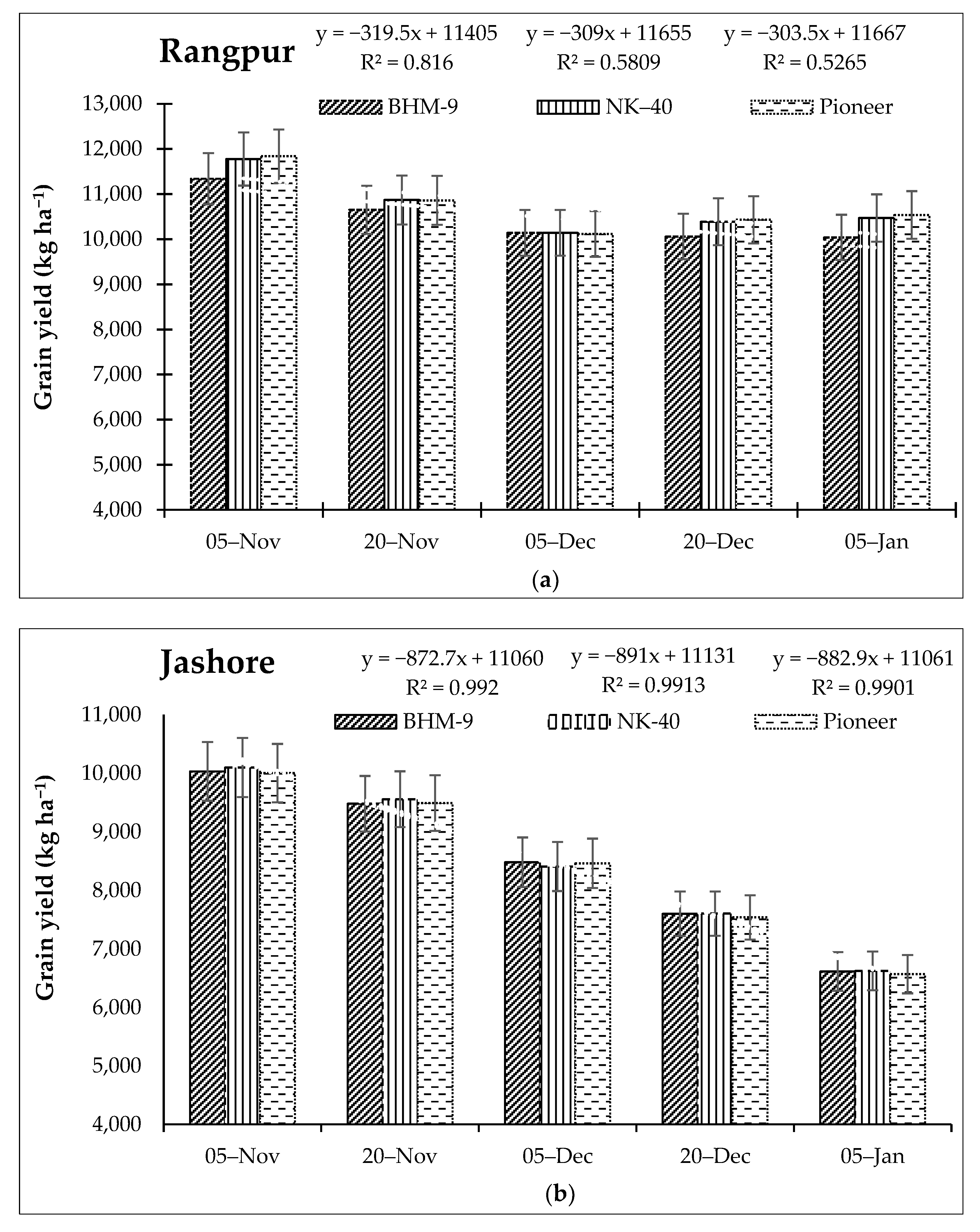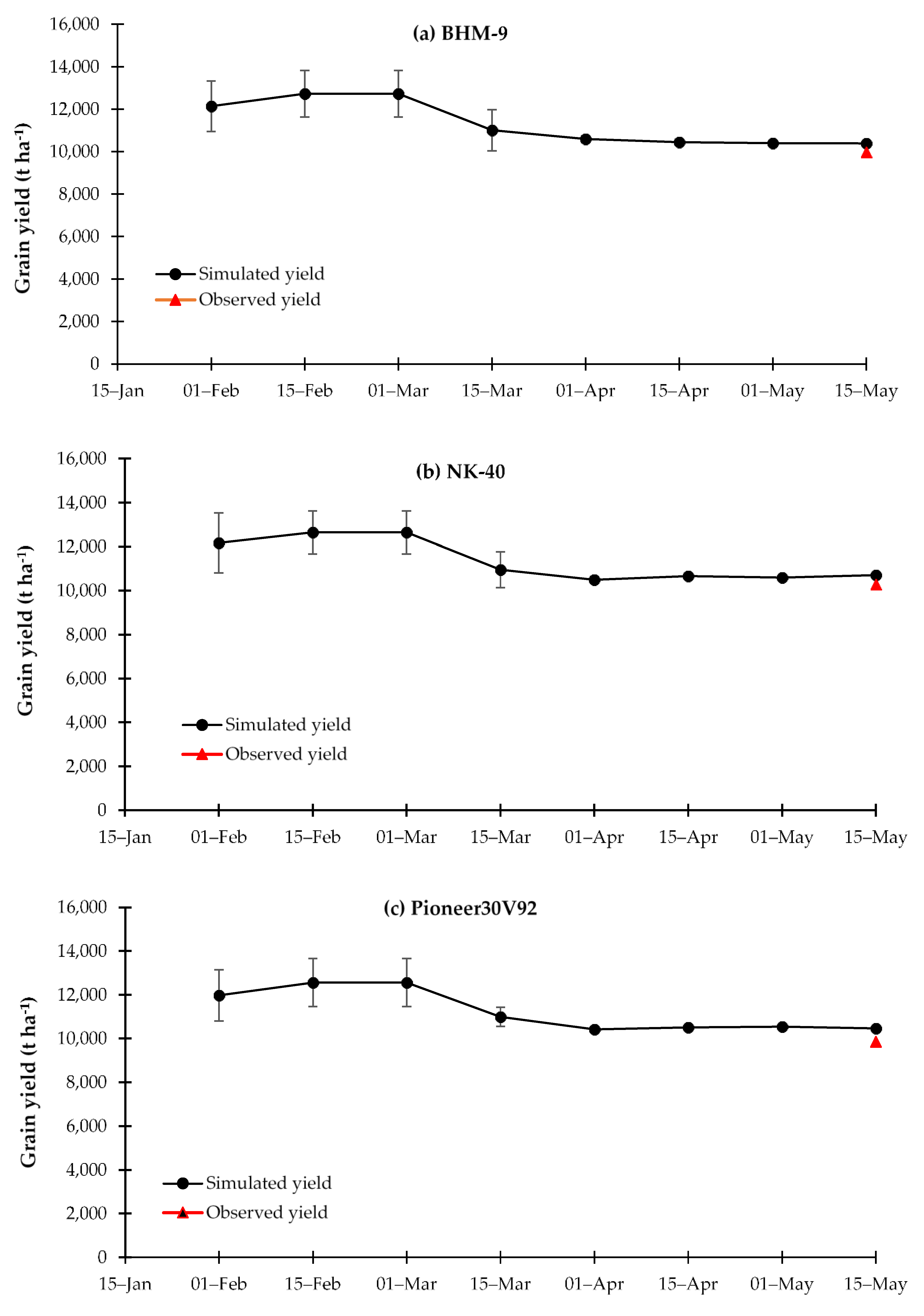Optimum Sowing Window and Yield Forecasting for Maize in Northern and Western Bangladesh Using CERES Maize Model
Abstract
1. Introduction
2. Materials and Methods
2.1. Field Experiments
2.2. Weather and Soil Information
2.3. Model Description
2.4. Model Calibration and Validation
2.5. Evaluation of CERES-Maize Model
2.6. Seasonal Analysis and Model Application
2.7. Yield Forecasting
3. Results and Discussion
3.1. Genetic Coefficient Determination
3.2. Model Calibration Results
3.3. Model Validation
3.4. Phenological Development Phases and Yields
3.5. Seasonal Outputs
3.6. Yield Forecasting
4. Conclusions
Author Contributions
Funding
Institutional Review Board Statement
Informed Consent Statement
Data Availability Statement
Acknowledgments
Conflicts of Interest
References
- BBS (Bangladesh Bureau of Statistics). Yearbook of Agricultural Statistics of Bangladesh; Government of Bangladesh: Dhaka, Bangladesh, 2016; pp. 95–96. [Google Scholar]
- Ali, M.Y.; Waddington, S.R.; Timsina, J.; Hodson, D.; Dixon, J. Maize-rice cropping systems in Bangladesh: Status and research needs. J. Agric. Sci. Technol. 2009, 3, 35–53. [Google Scholar]
- Tollenaar, M.; Dwyer, L.M. Physiology of maize. In Crop Yield, Physiology and Processes; Smith, D.L., Hamel, C., Eds.; Springer: Berlin/Heidelberg, Germany, 1999; pp. 169–204. [Google Scholar]
- Knoema, Bangladesh—Maize Production Quantity. Available online: https://knoema.com/atlas/Bangladesh/topics/Agriculture/Crops-Production-Quantity-tonnes/Maize-production (accessed on 12 March 2021).
- Muchow, R.C.; Sinclair, T.R.; Bennett, J.M. Temperature and Solar Radiation Effects on Potential Maize Yield across Locations. Agron. J. 1990, 82, 338–343. [Google Scholar] [CrossRef]
- Ahmed, J.; Elias, S.M. Socio-economic study of winter maize in some selected areas of Bangladesh. J. Rural Develop. 1988, 18, 60–68. [Google Scholar]
- Dahmardeh, M. Effects of sowing date on the growth and yield of maize cultivars (Zea mays L.) and the growth temperature requirements. Afr. J. Biotechnol. 2012, 11, 12450–12453. [Google Scholar] [CrossRef]
- Sur, H.S.; Sharma, A.R. Response to sowing dates and performance of different sunflower hybrids during rainy season in high-intensity cropping systems. Indian J. Agric. 1999, 69, 683–689. [Google Scholar]
- Soler, C.M.T.; Hoogenboom, G.; Sentelhas, P.C.; Duarte, A.P. Impact of Water Stress on Maize Grown Off-Season in a Subtropical Environment. J. Agron. Crop. Sci. 2007, 193, 247–261. [Google Scholar] [CrossRef]
- Zhao, Y.; Potgieter, A.B.; Zhang, M.; Wu, B.; Hammer, G.L. Predicting Wheat Yield at the Field Scale by Combining High-Resolution Sentinel-2 Satellite Imagery and Crop Modelling. Remote. Sens. 2020, 12, 1024. [Google Scholar] [CrossRef]
- Holzworth, D.P.; Huth, N.I.; Devoil, P.G.; Zurcher, E.J.; Herrmann, N.I.; McLean, G.; Chenu, K.; Van Oosterom, E.J.; Snow, V.; Murphy, C.; et al. APSIM—Evolution towards a new generation of agricultural systems simulation. Environ. Model. Softw. 2014, 62, 327–350. [Google Scholar] [CrossRef]
- Jones, J.W.; Hoogenboom, G.; Porter, C.H.; Boote, K.J.; Batchelor, W.D.; Hunt, L.A.; Wilkens, P.W.; Singh, U.; Gijsman, A.J.; Ritchie, J.T. The DSSAT cropping system model. Eur. J. Agron. 2003, 18, 235–265. [Google Scholar] [CrossRef]
- Rezzoug, W.; Gabrielle, B.; Suleiman, A.; Benabdeli, K. Application and evaluation of the DSSAT-wheat in the Tiaret region of Algeria. Afr. J. Agric. Res. 2008, 3, 284–296. [Google Scholar]
- Tovihoudji, P.G.; Akponikpè, P.B.I.; Agbossou, E.K.; Bielders, C.L. Using the DSSAT Model to Support Decision Making Regarding Fertilizer Microdosing for Maize Production in the Sub-humid Region of Benin. Front. Environ. Sci. 2019, 7, 1–15. [Google Scholar] [CrossRef]
- Hoogenboom, G.; Jones, J.W.; Wilkens, R.W.; Porter, C.H.; Boote, K.J.; Hunt, L.A. Decision Support System for Agro-Technology Transfer (DSSAT), version 4.6; DSSAT Foundation: Prosser, WA, USA, 2005. [Google Scholar]
- Adnan, A.A.; Jibrin, J.M.; Kamara, A.Y.; Abdulrahman, B.L.; Shaibu, A.S.; Garba, I.I. CERES–Maize Model for Determining the Optimum Planting Dates of Early Maturing Maize Varieties in Northern Nigeria. Front. Plant Sci. 2017, 8, 1118. [Google Scholar] [CrossRef]
- Adnan, A.A.; Jibrin, J.M.; Kamara, A.Y.; Abdulrahman, B.L.; Shaibu, A.S. Using CERES-Maize model to determine the nitrogen fertilization requirements of early maturing maize in the Sudan Savanna of Nigeria. J. Plant Nutr. 2017, 40, 1066–1082. [Google Scholar] [CrossRef]
- Corbeels, M.; Chirat, G.; Messad, S.; Thierfelder, C. Performance and sensitivity of the DSSAT crop growth model in simulating maize yield under conservation agriculture. Eur. J. Agron. 2016, 76, 41–53. [Google Scholar] [CrossRef]
- MacCarthy, D.S.; Adiku, S.G.K.; Freduah, B.S.; Gbefo, F.; Kamara, A.Y. Using CERES-Maize and ENSO as Decision Support Tools to Evaluate Climate-Sensitive Farm Management Practices for Maize Production in the Northern Regions of Ghana. Front. Plant Sci. 2017, 8, 31. [Google Scholar] [CrossRef] [PubMed]
- Lizaso, J.I.; Boote, K.J.; Jones, J.W.; Porter, C.H.; Echarte, L.; Westgate, M.E.; Sonohat, G. CSM-IXIM: A New Maize Simulation Model for DSSAT Version 4. Agron. J. 2011, 103, 766–779. [Google Scholar] [CrossRef]
- Kumar, R.; Singh, K.K.; Gupta, B.R.D.; Baxla, A.K.; Rathore, L.S.; Attri, S.D. Optimum sowing dates for soybean in central India using CROPGRO and ClimProb symbiosis. Meteorol. Appl. 2002, 9, 247–254. [Google Scholar] [CrossRef]
- Bannayan, M.; Crout, N.M.J.; Hoogenboom, G. Application of the CERES-Wheat Model for Within-Season Prediction of Winter Wheat Yield in the United Kingdom. Agron. J. 2003, 95, 114–125. [Google Scholar] [CrossRef]
- Wang, X.; Huang, J.; Feng, Q.; Yin, D. Winter Wheat Yield Prediction at County Level and Uncertainty Analysis in Main Wheat-Producing Regions of China with Deep Learning Approaches. Remote. Sens. 2020, 12, 1744. [Google Scholar] [CrossRef]
- Niedbała, G.; Nowakowski, K.; Rudowicz-Nawrocka, J.; Piekutowska, M.; Weres, J.; Tomczak, R.J.; Tyksiński, T.; Pinto, A. Álvarez Multicriteria Prediction and Simulation of Winter Wheat Yield Using Extended Qualitative and Quantitative Data Based on Artificial Neural Networks. Appl. Sci. 2019, 9, 2773. [Google Scholar] [CrossRef]
- Jahan, M.; Sen, R.; Ishtiaque, S.; Choudhury, A.K.; Akhter, S.; Ahmed, F.; Biswas, J.C.; Manirruzaman, M.; Miah, M.M.; Rahman, M.; et al. Optimizing sowing window for wheat cultivation in Bangladesh using CERES-wheat crop simulation model. Agric. Ecosyst. Environ. 2018, 258, 23–29. [Google Scholar] [CrossRef]
- Soler, C.M.T.; Sentelhas, P.C.; Hoogenboom, G. Application of the CSM-CERES-Maize model for planting date evaluation and yield forecasting for maize grown off-season in a subtropical environment. Eur. J. Agron. 2007, 27, 165–177. [Google Scholar] [CrossRef]
- Chisanga, C.B.; Phiri, E.; Shepande, C.; Sichingabula, H. Evaluating CERES-Maize Model Using Planting Dates and Nitrogen Fertilizer in Zambia. J. Agric. Sci. 2015, 7, 1–19. [Google Scholar] [CrossRef]
- Jones, J.W.; He, J.; Boote, K.J.; Wilkens, P.; Porter, C.; Hu, Z.; Ahuja, L.R.; Ma, L. Estimating DSSAT Cropping System Cultivar-Specific Parameters Using Bayesian Techniques. In Methods of Introducing System Models into Agricultural Research; John Wiley & Sons: Madison, WI, USA, 2011. [Google Scholar]
- Hunt, L.A.; Boote, K.J. Data for model operation, calibration and evaluation. In Understanding Options for Agricultural Production; Tsuji, G.Y., Hoogenboom, G., Thornton, P.K., Eds.; Kluwer Academic Publishers: Dordrecht, The Netherlands, 1998; pp. 9–39. [Google Scholar]
- Willmott, C. Some comments on the evaluation of model performance. Bull. Am. Meteorol. Soc. 1982, 63, 1309–1313. [Google Scholar] [CrossRef]
- Ahmed, I.; Rahman, M.H.U.; Ahmed, S.; Hussain, J.; Ullah, A.; Judge, J. Assessing the impact of climate variability on maize using simulation modeling under semi-arid environment of Punjab, Pakistan. Environ. Sci. Pollut. Res. 2018, 25, 28413–28430. [Google Scholar] [CrossRef]
- Kiniry, J.; Williams, R.; Vanderlip, J.; Atwood, D.; Muuliken, W.; Cox, H.; Weibold, W. Evaluation of two maize models for nine U.S. locations. Agron. J. 1997, 89, 421–426. [Google Scholar] [CrossRef]
- Jones, J.; Hoogenboom, G.; Wilkens, P.; Porter, C.; Tsuji, G. Decision Support System for Agrotechnology Transfer Version 4.Volume DSSAT v4.5: ICASA Tools; University of Hawaii: Honolulu, HI, USA, 2010. [Google Scholar]
- Liu, X.; Andresen, J.; Yang, H.; Niyogi, D. Calibration and Validation of the Hybrid-Maize Crop Model for Regional Analysis and Application over the U.S. Corn Belt. Earth Interact. 2015, 19, 1–16. [Google Scholar] [CrossRef]
- Mubeen, M.; Ahmad, A.; Wajid, A.; Khaliq, T.; Hammad, H.M.; Sultana, S.R.; Ahmad, S.; Fahad, S.; Nasim, W. Application of CSM-CERESMaize model in optimizing irrigated conditions. Outlook Agric. 2016, 45, 173–184. [Google Scholar] [CrossRef]
- Lin, Y.; Wu, W.; Ge, Q. CERES-Maize model-based simulation of climate change impacts on maize yields and potential adaptive measures in Heilongjiang Province, China. J. Sci. Food Agric. 2014, 95, 2838–2849. [Google Scholar] [CrossRef]
- Liaqat, W.; Ahmad, H.; Jan, M.F.; Ali, N.; Anjum, M.M.; Rehan, W. Effect of sowing dates on yield of different maize hybrids during summer in Nowshera, Pakistan. Middle East J. Agric. Res. 2018, 7, 554–558. [Google Scholar]
- Biswas, M. Direct Seeded and Transplanted Maize: Effects of Planting Date and Age of Seedling on the Yield and Yield Attributes. Am. J. Exp. Agric. 2015, 5, 489–497. [Google Scholar] [CrossRef]
- Porter, J.R.; Semenov, M.A. Crop responses to climatic variability. Phil. Trans. R. Soc. B 2005, 360, 2021–2035. [Google Scholar] [CrossRef] [PubMed]
- Thornton, P.; Bowen, W.; Ravelo, A.; Wilkens, P.; Farmer, G.; Brock, J.; Brink, J. Estimating millet production for famine early warning: An application of crop simulation modelling using satellite and ground-based data in Burkina Faso. Agric. For. Meteorol. 1997, 83, 95–112. [Google Scholar] [CrossRef]
- Garcia y Garcia, A.; Hoogenboom, G.; Soler, C.M.T.; Stooksburry, D.E. The impact of climate variability on peanut yield forecasts in Georgia. In Annual Meetings Abstracts [CD-ROM]; ASA, CSSA, and SSSA: Madison, WI, USA, 2003. [Google Scholar]
- Boggione, I.M.; Andrade, C.D.L.T.D.; Júnior, J.C.F.B.; Viana, J.H.M. Modeling Appliedto Sowing Dateof Irrigated Maize. Rev. Bras. MilhoSorgo 2018, 17, 201–215. [Google Scholar] [CrossRef]
- Amaral, T.A.; Andrade, C.D.L.T.D.; Alves, M.E.B.; Silva, D.F. Applying CSM-CERES-Maize to define a sowing window for irrigated maize crop—The Riacho´s Farm case study. Ambient. Agua Interdiscip. J. Appl. Sci. 2011, 6, 38–53. [Google Scholar] [CrossRef]




| Month | Average Temperature (°C) | Total Rainfall (mm) | Average Sunshine (h) | |||||
|---|---|---|---|---|---|---|---|---|
| Maximum | Minimum | |||||||
| Rangpur | Jashore | Rangpur | Jashore | Rangpur | Jashore | Rangpur | Jashore | |
| October | 30.7 | 32.5 | 22.5 | 22.9 | 169.1 | 124.0 | 7.2 | 6.2 |
| November | 28.5 | 30.3 | 17.3 | 17.4 | 7.8 | 28.2 | 7.8 | 6.8 |
| December | 24.8 | 26.7 | 13.0 | 12.5 | 7.9 | 11.1 | 6.7 | 6.1 |
| January | 23.0 | 25.4 | 10.9 | 11.1 | 9.1 | 13.4 | 6.1 | 6.3 |
| February | 26.4 | 29.0 | 13.4 | 14.7 | 11.7 | 25.4 | 7.5 | 7.2 |
| March | 30.5 | 33.6 | 17.5 | 19.7 | 27.6 | 42.3 | 7.8 | 7.4 |
| April | 31.7 | 35.9 | 21.3 | 23.6 | 117.9 | 72.6 | 7.1 | 7.6 |
| May | 31.9 | 35.5 | 23.4 | 25.2 | 284.7 | 180.3 | 6.5 | 6.9 |
| Soil Depth (cm) | Sand (%) | Silt (%) | Clay (%) |
|---|---|---|---|
| 0–15 | 11 | 63 | 26 |
| 15–30 | 11 | 60 | 29 |
| 30–60 | 14 | 33 | 53 |
| 60–90 | 27 | 38 | 35 |
| Soil Depth (cm) | pH | Bulk Density (g cm−3) | Organic Carbon (%) | TotalN (%) | Field Capacity (%) |
|---|---|---|---|---|---|
| 0–15 | 5.4 | 1.37 | 1.60 | 0.10 | 39.54 |
| 15–30 | 6.5 | 1.42 | 0.61 | 0.08 | 39.37 |
| 30–60 | 6.4 | 1.37 | 0.45 | 0.05 | 40.79 |
| 60–90 | 6.5 | 1.44 | 0.21 | 0.03 | 38.29 |
| Variety | Cultivar Specific Parameters (CSPs) | |||||
|---|---|---|---|---|---|---|
| P1 | P2 | P5 | G2 | G3 | PHINT | |
| BHM-9 | 308.1 | 0.300 | 950.6 | 785.1 | 8.40 | 47.00 |
| NK-40 | 310.0 | 0.300 | 948.0 | 782.0 | 8.50 | 47.00 |
| Pioneer30V92 | 306.0 | 0.300 | 940.0 | 776.0 | 8.50 | 47.00 |
| Parameters | R2 | RMSE | MAPE | NRMSE | D |
|---|---|---|---|---|---|
| BHM-9 | |||||
| Yield, kg ha−1 | 0.93 | 192 | 13.93 | 1.92 | 0.98 |
| Tops weight, kg ha−1 | 0.97 | 373 | 7.81 | 1.73 | 0.96 |
| * ADAP, days | 0.82 | 1.34 | 2.54 | 1.39 | 0.93 |
| * MDAP, days | 1 | 0.94 | 3.59 | 0.67 | 0.96 |
| NK-40 | |||||
| Yield, kg ha−1 | 0.97 | 401 | 13.21 | 3.89 | 0.98 |
| Tops weight, kg ha−1 | 0.91 | 476 | 7.21 | 2.21 | 0.92 |
| ADAP, days | 0.95 | 0.63 | 2.76 | 0.66 | 0.94 |
| MDAP, days | 1 | 0.94 | 3.73 | 0.67 | 0.96 |
| Pioneer30V92 | |||||
| Yield, kg ha−1 | 0.91 | 175 | 14.01 | 1.78 | 0.99 |
| Tops weight, kg ha−1 | 0.97 | 658 | 7.95 | 3.17 | 0.86 |
| ADAP, days | 0.93 | 0.85 | 3.00 | 0.89 | 0.91 |
| MDAP, days | 0.99 | 1.13 | 3.77 | 0.82 | 0.97 |
| Phenological Stages | Obs. | Sim. | % PD | Obs. | Sim. | % PD | Obs. | Sim. | % PD |
|---|---|---|---|---|---|---|---|---|---|
| BHM-9 | NK-40 | Pioneer30V92 | |||||||
| 5 November | |||||||||
| Anthesis day | 99 | 98 | 1.01 | 98 | 98 | 0.00 | 98 | 98 | 0.00 |
| Maturity day | 145 | 148 | −2.1 | 145 | 148 | −2.1 | 145 | 148 | −2.1 |
| Grain (kg ha−1) | 10,062 | 10,047 | 0.1 | 10,020 | 10,150 | −1.3 | 10,285 | 10,065 | 2.1 |
| Biomass (kg ha−1) | 22,319 | 23,231 | −4.1 | 23,457 | 23,464 | 0.0 | 22,633 | 23,310 | −3.0 |
| 20 November | |||||||||
| Anthesis day | 99 | 99 | 0.0 | 98 | 99 | −1.02 | 96 | 99 | −3.13 |
| Maturity day | 144 | 146 | −1.4 | 144 | 146 | −1.4 | 143 | 145 | −1.4 |
| Grain (kg ha−1) | 11,650 | 10,833 | 7.0 | 11,474 | 10,925 | 4.8 | 11,042 | 10,626 | 3.8 |
| Biomass (kg ha−1) | 22,306 | 23,207 | −4.0 | 17,440 | 18,617 | −6.7 | 22,075 | 23,328 | −5.7 |
| 5 December | |||||||||
| Anthesis day | 96 | 98 | −2.1 | 96 | 98 | −2.1 | 96 | 98 | −2.1 |
| Maturity day | 140 | 142 | −1.4 | 140 | 142 | −1.4 | 139 | 142 | −2.2 |
| Grain (kg ha−1) | 11,150 | 11,220 | −0.6 | 11,481 | 11,315 | 1.4 | 10,998 | 11,240 | −2.2 |
| Biomass (kg ha−1) | 22,763 | 23,557 | −3.5 | 21,701 | 23,405 | −7.9 | 23,115 | 23,287 | −0.7 |
| 20 December | |||||||||
| Anthesis day | 95 | 97 | −2.1 | 95 | 97 | −2.1 | 95 | 97 | −2.1 |
| Maturity day | 136 | 138 | −1.5 | 136 | 138 | −1.5 | 135 | 138 | −2.2 |
| Grain (kg ha−1) | 10,051 | 10,542 | −4.9 | 10,847 | 10,631 | 2.0 | 9904 | 10,561 | −6.6 |
| Biomass (kg ha−1) | 17,942 | 18,677 | −4.1 | 21,935 | 23,246 | −6.0 | 21,745 | 23,257 | −7.0 |
| 5 January | |||||||||
| Anthesis day | 93 | 93 | 0.0 | 92 | 93 | −1.1 | 91 | 92 | −1.10 |
| Maturity day | 131 | 132 | −0.8 | 130 | 131 | −0.8 | 129 | 130 | −0.8 |
| Grain (kg ha−1) | 7005 | 6937 | 1.0 | 7005 | 6937 | 1.0 | 6971 | 6730 | 3.5 |
| Biomass (kg ha−1) | 21,420 | 23,330 | −8.9 | 21,619 | 23,215 | −7.4 | 17,100 | 17,888 | −4.6 |
Publisher’s Note: MDPI stays neutral with regard to jurisdictional claims in published maps and institutional affiliations. |
© 2021 by the authors. Licensee MDPI, Basel, Switzerland. This article is an open access article distributed under the terms and conditions of the Creative Commons Attribution (CC BY) license (http://creativecommons.org/licenses/by/4.0/).
Share and Cite
Choudhury, A.K.; Molla, M.S.H.; Zahan, T.; Sen, R.; Biswas, J.C.; Akhter, S.; Ishtiaque, S.; Ahmed, F.; Maniruzaman, M.; Hossain, M.B.; et al. Optimum Sowing Window and Yield Forecasting for Maize in Northern and Western Bangladesh Using CERES Maize Model. Agronomy 2021, 11, 635. https://doi.org/10.3390/agronomy11040635
Choudhury AK, Molla MSH, Zahan T, Sen R, Biswas JC, Akhter S, Ishtiaque S, Ahmed F, Maniruzaman M, Hossain MB, et al. Optimum Sowing Window and Yield Forecasting for Maize in Northern and Western Bangladesh Using CERES Maize Model. Agronomy. 2021; 11(4):635. https://doi.org/10.3390/agronomy11040635
Chicago/Turabian StyleChoudhury, Apurba Kanti, Md. Samim Hossain Molla, Taslima Zahan, Ranjit Sen, Jatish Chandra Biswas, Sohela Akhter, Sheikh Ishtiaque, Faruque Ahmed, Md. Maniruzaman, Md. Belal Hossain, and et al. 2021. "Optimum Sowing Window and Yield Forecasting for Maize in Northern and Western Bangladesh Using CERES Maize Model" Agronomy 11, no. 4: 635. https://doi.org/10.3390/agronomy11040635
APA StyleChoudhury, A. K., Molla, M. S. H., Zahan, T., Sen, R., Biswas, J. C., Akhter, S., Ishtiaque, S., Ahmed, F., Maniruzaman, M., Hossain, M. B., Sarker, P. C., Dessoky, E. S., Hassan, M. M., & Hossain, A. (2021). Optimum Sowing Window and Yield Forecasting for Maize in Northern and Western Bangladesh Using CERES Maize Model. Agronomy, 11(4), 635. https://doi.org/10.3390/agronomy11040635










